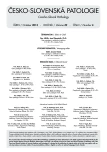Immunophenotypization by means of flow cytometry in pathology
Authors:
Petra Manďáková; Jarmila Čandová
Authors‘ workplace:
Ústav patologie a molekulární medicíny, 2. LF UK a FN v Motole, Praha
Published in:
Čes.-slov. Patol., 49, 2013, No. 4, p. 126-130
Category:
Review articles
Overview
Flow cytometry represents a modern analytical method useful for an assessment of selected cellular subpopulations in suspension (peripheral blood, aspirate of bone marrow, liquid fluid etc. and also in suspensions prepared from non-fixed solid tumors) in clinical and research laboratories. The method provides information on numerous surface or intracellular markers of the analyzed elements at the same time. The usage of fluorescent monoclonal antibodies against surface or intracellular antigens associated with specific type of cells (T-lymphocytes, B-lymphocytes etc.), with their developmental stage, or with monoclonality (for example antibodies against light chains of immunoglobulins), are the most valuable for the clinical practice.
The most important application of flow cytometry in pathology has remained in hematologic malignancies, where this fast and exact method provides, practically in a real time, crucial information for correct diagnosis as well as for the choice of optimal therapy, and subsequently for assessing the effect of the therapy.
Keywords:
flow cytometry – immunophenotypization – non-Hodgkin lymphomas
Sources
1. Fulwyler MJ. Electronic separation of biological cells by volume. Science 1965; 150: 910-911.
2. Robinson JP. Mack Fulwyler in his own words. Cytometry Part A 2005; 67A: 61-67.
3. Herzenberg LY. FACS innovation: a view from Stanford. Clin Invest Med 2004; 27: 240-252.
4. Zuba-Surma EK, Kucia M, Abdel-Latif A, Lillard JW Jr., Ratajczak MZ. Folia Histochem Cytobiol 2007; 45: 279-290.
5. Hulett HR, Bonner WA, Barrett J., Herzenberg LA. Cell sorting: automated separation of mammalian cells as a function of intracellular fluorescence. Science 1969; 166: 747-749.
6. Shapiro HM. Multistation multiparameter flow cytometry: a critical review and rationale. Cytometry 1983; 3: 227-243.
7. Shapiro HM. Practical flow cytometry. Alan R. Liss, Inc: New York; 1988.
8. Radcliff G, Jaroszeski MJ. Basics of flow cytometry. Methods Mol Biol 1998; 91: 1-24.
9. Jaroszeski MJ, Radcliff G. Fundamentals of flow cytometry. Mol Biotechnol 1999; 11: 37-53.
10. Maftah A, Huet O., Gallet PF, Fatinaud MH. Flow cytometryęs contribution to the measurement of cell functions. Biol Cell 1993; 78: 85-93.
11. Stewart CC. Clinical applications of flow cytometry. Immunologic methods for measuring cell membrane and cytoplasmic antigens. Cancer 1992; 69: 1543-1552.
12. Davey HM. Flow cytometric techniques for the detection of microorganisms. Methods Cell Sci 2002; 24: 91-97.
13. Arora SK. Analysis of intracellular cytokines using flowcytometry. Methods Cell Sci 2002; 24: 37-40.
14. Gadol N, Crutcher GJ, Busch MP. Detection of intracellular HIV in lymphocytes by flow cytometry. Cytometry 1994; 15: 359-370.
15. Riley RS, Mahin EJ. Clinical applications of flow cytometry. ASCP: San Francisco; 1990.
16. Croudr J, Leitenberg D, Smith BR, Howe JG. Epstein-Barr virus suspension cell assay using in situ hybridization and flow cytometry. Cytometry 1997; 29: 50-57.
17. Jaffe ES, Harris NL, Stein H, Vardiman JW. WHO classification of tumours; Pathology and genetics of tumours of hematopoietic and lymphoid tissue. IARC Press: Lyon; 2001: 135-174.
18. Manďáková P, Campr V, Kodet R. Korelace výsledků průtokové cytometrie a morfologických nálezů v diagnostice maligních lymfomů z B buněk. Čas Lék Čes 2003; 142: 651-655.
19. Manďáková P, Kortánková H, Machovcová A, Campr V. Imunofenotypizace kožních T-lymfomů. Čes-slov Derm 2006; 2: 82-87.
Labels
Anatomical pathology Forensic medical examiner ToxicologyArticle was published in
Czecho-Slovak Pathology

2013 Issue 4
Most read in this issue
- How to improve the histopathological diagnosis of hepatocellular benign affections (adenoma versus focal nodular hyperplasia) in daily practice?
- Immunophenotypization by means of flow cytometry in pathology
- Minimal residual disease – detection possibilities in haematological and non-haematological malignancies
- Fluorescence in situ hybridization on histologic sections
